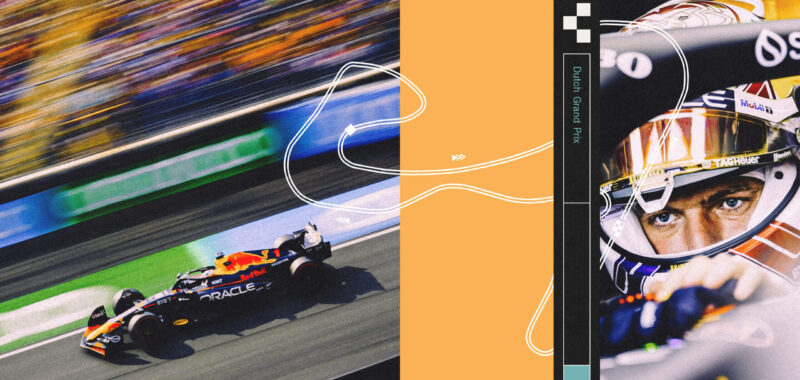Stay informed on all the biggest stories in Formula One. Sign up here to receive the Prime Tire newsletter in your inbox every Tuesday and Friday morning.
Formula One is back in session after a lengthy summer break where drivers and the rest of the paddock recharged for the upcoming 10-race stretch that lasts until December.
The Dutch Grand Prix starts that stretch as the sport heads to the beachside town of Zandvoort, roughly a 30-minute train ride from Amsterdam. And while most grandstands feature an array of colors, this race’s grandstands are a sea of orange-clad fans.
Track position is crucial given how the narrow Circuit Zandvoort limits overtaking opportunities, but passing is not impossible. Banked corners provide avenues for drivers to take different lines and battle.
“Undulating” is a widely-used term to describe the nature of the circuit as the ebbs, flows and banking create a rollercoaster-type feel. The twisty track is hard on the tires, so it’s likely safe to expect a multi-stop race. Precision is required as drivers navigate around the banks and gravel traps, leaving little room for error. And as a beachside town, sand and dirt will drift onto the track throughout the weekend, creating another obstacle for teams.
Key Specs
- Circuit length: 4.259 km (2.646 miles)
- Number of laps: 72
- Race distance: 306.587 km (190.504 miles)
- Lap record: 1:11.097 (Lewis Hamilton, 2021)
- First GP: 1952

Around the sand dunes
Tight, twisty and with some banked corners, Circuit Zandvoort gives a challenging old-school vibe. Qualifying is a crucial session given the limited overtaking opportunities, and concentration is needed as drivers navigate fewer long straights and steep banking (some of which rival that of the Indianapolis Motor Speedway).
The track originally was a mix of public roads and a permanent circuit, and the Dutch Automobile Racing Club had 1927 24 Hours of Le Mans winner Sammy Davis consult on the original layout. Like the UK’s Silverstone, Zandvoort was part of the post-war motorsport wave. From 1952 to 1985, it became one of the most used circuits, though F1 raced at the track on and off. The likes of Juan Manuel Fangio, Graham Hill, Jim Clark, Niki Lauda and Jackie Stewart have all won at this track. One of the most iconic moments came during the 1979 race when Gilles Villeneuve completed a three-wheel lap.
F1 went on a 36-year hiatus from Zandvoort before returning the circuit to the calendar in 2021 (the initial announcement was made for 2020, but the COVID-19 global pandemic delayed its return). The track has been modernized since its creation. The first half still uses the corners from the 1948 layout, but the second half (introduced in 1999) was remodeled.
The turns that define Zandvoort
Turn 1: Tarzan
This is one of the most famous corners at Zandvoort, given the banking angle (18 degrees, which rivals Indianapolis Motor Speedway). The wide bend gives the drivers a rare overtaking opportunity.
Turn 2: Gerlach
The left bend is named in honor of Wim Gerlach, a Dutch driver who died following a wreck during a 1957 sportscar race.
Turn 3: Hugenholtz
Hello, banking. Drivers take as high a line as possible through this sweeping turn to essentially create a maximum-speed slingshot. They’ll brake fairly late, looking like they will collide with the barrier.
This corner was named in honor of Hans Hugenholtz, the track’s first director. He designed numerous circuits, like part of the Hockenheimring in Germany and Suzuka, but he did not design Circuit Zandvoort.

Turn 5: Slotemaker
This is another portion of the track named after a driver who was killed. Rob Slotemaker, a Dutch racer, died at this turn during a touring car race in 1979.
Turns 6 and 7: Scheivlak
According to the circuit’s website, this is “the turn where the heroes distinguish themselves from the regular drivers.” The turn is at the top of a dune hill and slopes to the right, creating a rather fast challenge. Some changes were made during the 2020 upgrade, like adding new FIA fences to the left, but Scheivlak’s original shape remains.
Turns 11 and 12: Hans Ernst Bocht
This chicane provides another overtaking opportunity to drivers as they near the end of a lap, approaching it at high speeds before braking to nail the sequence.
The turn was added in 1989 and originally was named Nissanbocht. But in recent years it became known as Hans Ernst Chicane in honor of the former circuit director. The second portion of the chicane was widened, allowing different racing lines to be taken.
Final corner: Arie Luyendyk
This name may ring a bell for IndyCar fans — Arie Luyendyk is a two-time Indianapolis 500 winner. Turn 14 features banking nearly twice as steep as Indianapolis at 18 degrees (32%) but not nearly as strong as the likes of the original Monza layout. Drivers zip around the righthander and exit into the long straight (with DRS).

Circuit curiosities
- The circuit fell into financial trouble and went bankrupt in 1987.
- The first race at Zandvoort (before the F1 days) was won by a royal — Thai Royal Prince Birabongse Bhanudej Bhanubandh (aka Prince Bira of Siam).
- The most pole positions at Circuit Zandvoort is three, a record held by Rene Arnoux that Max Verstappen has equaled.
- Jim Clark still holds the most wins (four), but Verstappen isn’t far behind, sitting at three victories.
- Ferrari is the winningest constructor at Circuit Zandvoort (eight wins).
Design: Drew Jordan/The Athletic

